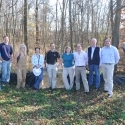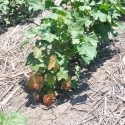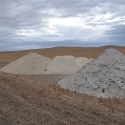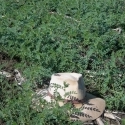Ammonium Sulfate as a specialty fertilizer for canola
Most growers recognize that canola has a much higher demand for sulfur than cereals, with the oilseed having almost three times the grain S concentration compared to wheat. To meet this demand, many growers use low rates of gypsum (calcium sulfate) applied before sowing, and then meeting the N demand with a combination of at-sowing and topdressed urea. This strategy is now coming under investigation, especially the S strategy in low rainfall regions where the relatively low solubility and sometimes variable S content of gypsum can be a problem.
In collaboration with Incitec Pivot and the International Plant Nutrition Institute, University of Melbourne student, Tauhid Khan is investigating the role that ammonium sulfate (AmS) can play as a fertilizer for cropping systems in southeastern Australia. A pot experiment conducted at Horsham showed that after 42 days, canola responded to AmS more than to an equivalent rate of N and S from urea and gypsum. Compared to the control, AmS gave +104% growth response compared to urea/gypsum (+61%). When a similar experiment was done using wheat as the test crop, AmS and urea/gypsum produced similar responses.
To test these effects, field experiment were established at Pira (west of Swan Hill, canola cv 44C79) and Nurrabiel (southwest of Horsham, canola cv 44C79 and wheat cv Derrimut). Both sites were expected to respond to S and a range of fertilizers were compared. At both sites, nil fertilizer was compared to urea, gypsum, urea/gypsum together and ammonium sulfate to supply 35kg N and/or 40kg S at sowing. The crops were sown on May 11 (Pira) or May 22 (Nurrabiel) with 15 or 20 kg P.
At the Pira site with canola, there was a significant (p<0.05) yield response to both applied S as gypsum with or without urea (+44%), but no significant response to urea alone. However, when both N and S were supplied as ammonium sulfate, there was a larger (+75%) yield response.
At Nurrabiel, neither urea nor gypsum alone, or in combination, gave a significant grain yield response, but when N and S were supplied together as AmS, then yields significantly increased by almost 30% (1.83 t/ha urea/gypsum compared to 2.36 t/ha AmS). In fact, the urea/gypsum treatment was not significantly different from the nil fertilizer.
There was no effect of any of the treatments on wheat grain yield at Nurrabiel.
At the present time, we do not have the nutrient levels in the plant tissues so cannot draw particular conclusions about differential N or S uptake from urea/gypsum or AmS. However it seems reasonable to conclude that the S from gypsum was somewhat less available than the S from the AmS at the both these sites. Alternatively, there may be some synergistic effect of having N and S placed together with AmS, as similar effects have sometimes been noted with the co-placement of N and P for cereals.
These results open up several possible areas to investigate the role that AmS can play in cropping systems. It has been known for a long time that AmS is an acidifying fertilizer and the results from the pot experiment supported that conclusion. Lowering pH on highly alkaline and calcareous soils may improve the availability of other nutrients (eg P). Alternatively, the placement of N and S together at sowing means they would move down the soil profile basically together rather than getting out of phase with root growth.
A clear understanding of why AmS performed better than urea and gypsum will provide growers with guidelines about where this fertilizer can be reliably used. It is also possible that blending AmS with other N sources could provide new types of mixed nutrient fertilizers for canola and other crops where N and S are demanded.
Mr Khan is supervised by Dr Rob Norton (International Plant Nutrition Institute), Dr Rob Edis and Professor Deli Chen (both University of Melboure) and his scholarship is provided by Incitec Pivot Ltd. The authors would like to acknowledge the co-operation of Mr Rob Christie (ex-Incitec Pivot), Mr Peter Howie (University of Melbourne), and the landholders John Russell (Nurrabiel) and Luke Maher (Pira) on whose sites these experiments were conducted.
Mr Tauhid Khan in taking field notes at the Nurrabiel wheat and canola site in western Victoria.




